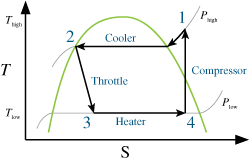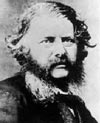
The refrigerator is one of those miracles of modern living that totally changed our lives. The basic idea behind a refrigerator is that it uses the evaporation of a liquid to absorb heat. The liquid, or refrigerant, evaporates at an extremely low temperature so it can create freezing temperatures.
The most widely used refrigeration principle is vapor compression, also referred to as the reverse-Rankine cycle. It operates around the refrigerant’s saturation curve (shown in green):

The refrigerant starts as a gas and is compressed and cooled to a liquid. The liquid is throttled to a lower pressure and evaporated to absorb heat, and recycled to be compressed once again, completing the cycle.
This cycle takes advantage of the universal gas law:
PV=nRT,
where P is pressure, V is volume, R is the universal gas constant, T is temperature, and n is the number of moles of gas (1 mole = 6.022x1023 molecules).



